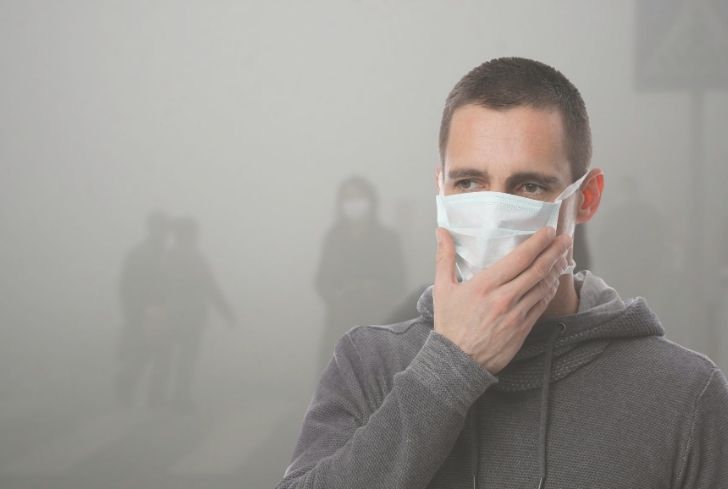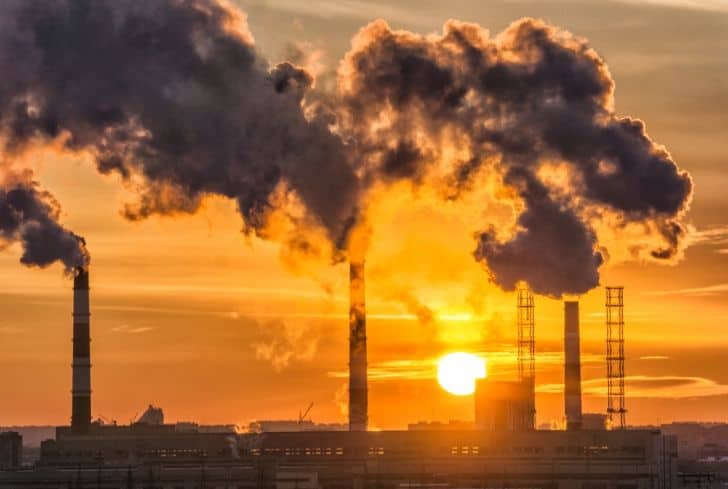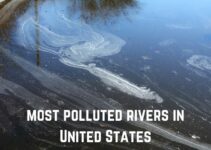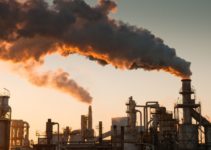“Air quality” refers to the condition of the air within our surroundings. Good air quality pertains to the degree to which the air is clean, clear and free from pollutants such as smoke, dust and smog, among other gaseous impurities in the air. Air quality is determined by assessing a variety of pollution indicators. Good air quality is a requirement for preserving the exquisite balance of life on earth for humans, plants, animals and natural resources. As such, human health, plants, animals and natural resources are threatened when pollution in the air reaches high concentrations.
Poor air quality can affect or harm human health and/or the environment. Air quality can be degraded by natural or man-made sources. Natural sources include volcanic eruption, windstorm dust. Man-made sources include pollution from moving vehicles, toxic gases from industries, coal-powered plants, burning wood or other material in the open air, landfills. Both these sources can seriously affect the overall air quality and can lead to severe health problems for humans.
According to British Columbia (BC),
The term “air quality” means the state of the air around us. Good air quality refers to clean, clear, unpolluted air. Clean air is essential to maintaining the delicate balance of life on this planet — not just for humans, but wildlife, vegetation, water and soil. Poor air quality is a result of a number of factors, including emissions from various sources, both natural and “human-caused.”
How is Air Quality Degraded?
Air quality is degraded by the day to day emissions from different air pollution sources. These include stationary sources such as power plants, manufacturing facilities, smelters, motor machines, and burning wood and coal; mobile sources such as trucks, buses, planes and cars; and natural sources such as volcanic eruptions and windstorm dust.
The pollutants from these sources are released into the air, which can affect the health of humans, animals and our environment. The quality of air depends on 3 factors: the amount of pollutants, the rate at which they are released in the atmosphere, and how long they are trapped in an area.
The air pollution sources emit a wide range of pollutants classified under different categories that include Sulfur Dioxide (SO2), particulate matter, Hydrocarbons (HC) and volatile organic compounds (VOC), Lead, Carbon Dioxide (CO2) and Carbon Monoxide (CO), Nitrogen Oxides (NOx), and Smog. In most regions, noticeable air quality degraders include smoke, dust, CO, NOx, SO2, HC, and smog from factories, power plants, automobiles, and smelters, especially around urban and industrial areas.
Many of these air pollutants occur as gases, but some are very tiny solid particles, such as dust, smoke or soot. Air pollution from various sources can affect indoor air as well. Removing the pollutants from indoor air can improve the quality of your indoor air. Indoor air pollutants include cigarette smoke, mold, dust mites, pet dander, formaldehyde, volatile organic compounds (VOCs) and radon gas.
If air pollutants are in an area with good airflow, they will mix with the air and quickly disperse. Air pollutants tend to remain in the air when there are certain conditions like light winds or mountains that restrict the transport of these pollutants away from an area. When this happens, pollution concentrations can increase rapidly.
How to Improve Air Quality?
With all those toxic pollutants in the atmosphere, it isn’t easy to get fresh as it used to be. Due to the increase in number of vehicles and industries on a large scale, the air quality has gone from bad to worse in the last few decades. Every year, millions of people across the globe die due to inhaling toxic gases present in the atmosphere.
There are several measures which we can take to make air quality better not only for us but even for the coming generations. If not done in a proper and timely manner, the worsening air quality can cause severe harm to the entire planetary ecosystem.
1. Dealing With Traffic and Vehicle Emissions
In a bid to improve air quality, dealing with automobile emission is the first choice for action. Beginning by reducing the numbers of automobile traffic and the use of cleaner vehicles is the best course of action towards cutting down on emissions locally. Promoting public transport and proper urban planning can as well aid in reducing traffic numbers. Nowadays, journeys have become shorter and affordable due to the introduction of fast electric trains and other forms of cheaper public transport.
By promoting public transport, it is easy to get people out of their vehicles, which suggests that it’s an obvious answer to reducing the number of cars on the road. Air pollution reduction can also be accomplished through speed reduction, promoting the use of electric/hybrid cars, rerouting traffic, and introducing access restrictions. Through this, CO2, lead, smoke, and particulate matter from road traffic emissions can considerably reduce, thereby improving air quality.
Besides the use of cleaner vehicles and the promotion of public transport, use of green fuels is a good alternative for improving air quality.
2. Dealing With Industrial Emissions
Factories and industrial manufacturing companies are another main concern when it comes to air pollution. Industries are the biggest air pollution sources as they emit high scores of pollutants into the air on a daily basis. Due to industrial emissions, the globe faces a great challenge of acid rain, ozone layer depletion, and global warming. Primary regulation policies by environmental agencies are required to regulate industrial emissions with the aim of large scale structural emission reduction from industrial facilities.
Control devices termed as “pollution-eating nano-particles” can as well offer effective ways to reduce industrial air pollution by absorbing or destroying toxic emissions and contaminants from industries. It is realized through the installation of particulate control devices in exhaust streams. Good examples include Titanium dioxide and ultraviolet light. When installed in an industrial facility, titanium dioxide reduces pollution by absorbing toxic emissions, while ultraviolet light breaks up NOx gases and VOCs.
Other control devices include electrostatic precipitators, dust cyclones, particulate scrubbers, and bag-houses. Switching to the use of renewable energy is the most effective mechanism for improving air quality standards in industrial manufacturing.
3. Eco-friendly transportation
Riding a bike or walking instead of driving, buying a car that has greater fuel efficiency or shifting to electric vehicles and hydrogen vehicles, and promoting shared mobility (i.e., carpooling and public transports) could reduce air pollution.
Making a vehicle more fuel-efficient is also a part. Lighter and more streamlined vehicles need less energy. Hybrid vehicles have an electric motor and a rechargeable battery. The energy that would be lost during braking is funneled into charging the battery, which then can power the car.
The internal combustion engine only takes over when power in the battery has run out. Hybrids can reduce auto emissions by 90% or more, but many models do not maximize the possible fuel efficiency of the vehicle.
4. Renewable fuel and clean energy production
The most basic solution for air pollution is to move away from fossil fuels, replacing them with alternative energies like solar, wind and geothermal. It is important that regions develop what best suits them. While the desert Southwest will need to develop solar, the Great Plains can use wind energy as its energy source. Perhaps some locations may rely on nuclear power plants. Sometimes technological approaches are needed.
5. Energy conservation and efficiency
Producing clean energy is crucial. But equally important is to reduce our consumption of energy by adopting responsible habits and using more efficient devices. Turning off lights and appliances when they are not in use, using energy-efficient light bulbs and appliances, buying fewer things that are manufactured using fossil fuels, all these actions reduce the amount of energy that power plants need to produce.
6. Reducing Greenhouse Gases
Climate scientists agree that climate change is a global problem that must be attacked by a unified world with a single goal. All nations must come together to reduce greenhouse gas emissions. However, getting nations to agree on anything has proven to be difficult. A few ideas have been proposed and in some nations are being enacted.
The first attempt to cap greenhouse gas emissions was the Kyoto Protocol that set up a cap-and-trade system. Cap-and-trade provides a monetary incentive for nations to develop technologies that will reduce emissions and conserve energy. Some states and cities within the United States have begun their own cap-and-trade systems.
The United Nations Climate Change Conference meets in a different location annually. Although recommendations are made each year, the group has not gotten the nations to sign on to a binding agreement. By doing nothing, we are doing something, and that is continuing to raise greenhouse gas levels and failing to prepare for the coming environmental changes.
7. Carbon Tax
A carbon tax can be placed on CO2 emissions to encourage conservation. The tax would be placed on gasoline, carbon dioxide emitted by factories, and home energy bills so people or businesses that emit more carbon would pay more money. This would encourage conservation since when people purchase a new car, for example, they would be more likely to purchase an energy-efficient model. The money from the carbon tax would be used for research into alternative energy sources.
All plans for a carbon tax allow a tax credit for people who cannot afford to pay more for energy so that they do not suffer unfairly.This could be one easiest and quickest way is to reduce greenhouse gas emissions and increase energy efficiency.
8. Carbon Capture and Sequestration
People can attempt to remove greenhouse gases from the atmosphere after they are emitted. Carbon sequestration occurs naturally when carbon dioxide is removed from the atmosphere by trees in a forest. One way to remove carbon would be to plant more trees, but unfortunately, more forest land is currently being lost than gained.
Carbon can also be artificially sequestered. For example, carbon can be captured from the emissions from gasification plants and then stored underground in salt layers or coal seams. While some small sequestration projects are in development, large-scale sequestration has not yet been attempted.
9. Reducing Ozone Destruction
One success story in reducing pollutants that harm the atmosphere concerns ozone-destroying chemicals. In 1973, scientists calculated that CFCs could reach the stratosphere and break apart. This would release chlorine atoms, which would then destroy ozone. Based only on their calculations, the United States and most Scandinavian countries banned CFCs in spray cans in 1978.
The Montreal Protocol controls the production and consumption of 96 chemicals that damage the ozone layer (Figure below). Hazardous substances are phased out first by developed nations and one decade later by developing nations. More hazardous substances are phased out more quickly.
CFCs have been mostly phased out since 1995, although those were used in developing nations until 2010. Some of the less hazardous substances will not be phased out until 2030. The Protocol also requires that wealthier nations donate money to develop technologies that will replace these chemicals.
10. Establishment of Policies and Clean Air Action Plans
Air quality improvement equally requires a string of directives, support, and initiatives geared towards emission reduction not only locally but internationally as well. Local, national and international environmental protection agencies need to work hand in hand to ensure the set air quality levels are met.
It’s a commitment that can only be achieved through an effective environmental action plan, strategies and policies directed towards addressing the underlying air pollution challenges.
For instance, the Clean Air for Europe (CAFE) and the Environmental Protection Agency (EPA) programs have set standards for restricting air pollution, and it has since resulted to a new directive for clean and quality air. Established about a decade ago, the directives have managed to set in place emission goals and standards for air quality.
Objectives are set whereby all sorts of air pollutants have to be regulated and cut down to a standard level and also managed within the scope of the challenges experienced. In challenging situations, deadlines for complying must be instituted and upheld. As such, the creation of action plan directives similar to CAFE’s, EPA’s or any other devoted environmental protection agency can offer a wonderful advancement in the direction of improving air quality.
To work towards the attainment of improving the air quality situation, each state and nation without air regulation policies can make it a requirement to develop an action plan for cleaning the air within their jurisdiction. In addition to the development of an action plan, implementation is essential as it defines the efforts that will improve and attempt to regulate the air pollution levels and to improve the air quality of the region.
Also, various environmental protection and clean air support programs, states, and nation can establish monitoring criteria for pollutants. One similar program is the Ambient Air Monitoring that has been adopted by various nations and states. Through the program, statistics can be collected regarding air quality by measuring samples so as to estimate the attainment of the set air quality standards.
In this sense, pollution trends can be observed throughout the jurisdiction region to deter or reduce current air pollution crisis. Other air quality monitoring programs can encompass Air Pollution Monitoring and Enhanced Ozone Monitoring.
Air pollution reduction efforts can also involve land-use, urban, and transportation planning strategies. The utilization of these strategies can assess the root causes of air pollution and to install measures for dealing with the challenges experienced.
Accordingly, environmental clean air policies and programs can be established to address issues regarding the quality of air as a factor directly impacting human health and the environment. The world, particularly regions burdened with the air pollution challenge, can thus improve air quality by adopting or establishing clean air action plans and support programs.
Conclusion
Reducing emissions contributing to poor air quality, climate change, and ozone layer depletion requires a collaborative effort and long-term commitment. To be part of the required solution, society, people, businesses, manufacturing facilities, and government authorities need to work as a team to realize the positive outcomes of having a healthier and more sustainable environment.
In general, the sources, causes and impacts of air quality are interlinked. That means dealing with one air quality concern can very much lessen other categories of air pollution. For instance, cutting back on fossil fuel usage not only helps to reduce the emission of particulate matter but also lessens CO2, CO and NOx emissions from vehicle exhaust.
In the long run, efforts to improve air quality reward the entire humanity by improving human wellbeing and health, reducing the costs of health, and increasing environmental productivity.
Sources:
Lenz, H. P., & Cozzarini, C. (1999). Emissions and air quality. Warrendale, PA: Society of Automotive Engineers, 1999. 140.
World Health Organization (WHO). (2005). WHO Air Quality Guidelines Global Update 2005: Report on a Working Group Meeting, Bonn, Germany, 18-20 October 2005. WHO Regional Office for Europe.
World Health Organization (WHO). (2000). Air quality guidelines for Europe.







